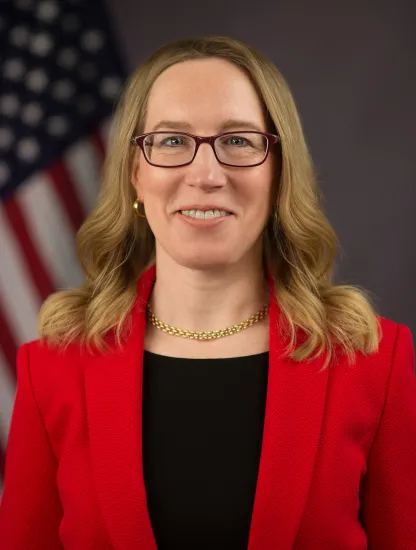Hester Peirce was appointed as a Commissioner at the Securities and Exchange Commission just a year into Trump’s first term and has served as one of its leading voices now for close to seven years. A securities lawyer by trade with a glittering career in the public sector, including a stint as a counsel to (the potential) incoming Chair Paul Atkins, Peirce has spent her time at the SEC as a vocal advocate for the U.S. capital markets.
During those seven years she has often publicly rebuked incumbent Chair Gary Gensler, particularly clashing on his approach to cryptocurrency regulation and his overzealous use of the enforcement division to regulate the wider industry. She has regularly called the Commission out for the rapid pace of introducing new regulations, hindering its ability to properly engage with the public to ensure new implementations are concise and to take comments into account to avoid bad outcomes.
But after four years of sparring with Gensler, his time left in the role can be counted in days rather than months. With Paul Atkins likely to come to the helm to take over and a new dawn of SEC oversight that is pro-crypto, pro-market, enforcement- and regulation-lite, Republican Peirce will be on the majority side at the Commission once again.
Institutional Investor’s John Crabb spoke to Commissioner Peirce to discuss her thoughts on the new regime and her hopes and dreams for oversight of the asset management industry.
John Crabb: Good afternoon, Hester, thanks very much for joining me today. So, given there is a new look SEC on the horizon with a new leader, what do you think the priorities should be over the next few years?
Hester Peirce: I can't speak for Paul. But I think we'll spend more time thinking about capital formation, what we can do to get capital to the smallest companies, and how can we make it more attractive to be a public company.
We will also look at how to right-size regulations for companies in the public markets, how to expand opportunities for investors to get access to a broader diversity of investments, and how to expand the reach of the capital markets. We can do this both by making sure that more investors enter, and that companies continue to look to the U.S. capital markets to raise money.
I expect that there will be a focus on some bread-and-butter things as well, agency operation and rule makings and that sort of thing. There is a lot to do, but he knows that so I expect that he'll focus on things that matter a lot but don't always get a lot of attention.
JC: And are there any specific rules or proposals that Gary Gensler has introduced that you'd be keen to get rid of?
HP: There are ones I wasn't too enthusiastic about when they were proposed, and we've gotten a lot of negative comments on. So, we need to think about what to do with things like the Custody Rule for investment advisors; Rule 3b-16, which would define the term exchange and raised a lot of questions; and the Digital Engagement Practice rule making caused a lot of consternation as well. I would like us to look at these.
We did adopt some of the Equity Market Structure reforms, but there was a lot of comments that we didn't move forward with so thinking about what to do with those as well. Those were rules that I was not enthusiastic about it, and neither were a lot of commenters.
Are any of these changes, or others, going to be specifically welcome by asset managers and institutional investors?
A lot were very concerned about the Custody Rule. I'd like to look at some questions around disclosure, whether we're requiring it to be paper or electronic, and allowing more flexibility so that asset managers can communicate effectively with investors. We can look at whether the Custody Rule needs to be modernized, but we have to do it carefully.
I hope we can take up some rules around cross trading, and I hope we can do a better job around innovation in the asset management space. That's not necessarily going to involve rulemaking but signaling to the industry that the doors are open in terms of people coming in for exemptive relief.
Exemptive relief has traditionally been the way that the SEC has allowed or accommodated innovation in the asset management industry, so I'm encouraged to think about opening those doors again, seeing what people come in with, and working with them to try to get those products to market.
Are there any recently implemented rules or regulations that you think were done right and should remain in place?
I don't think that a new SEC comes in and changes everything. But if you look at something like Treasury clearing, where you know that mandate is in place, what we ought to be doing is looking at how we can help people on the implementation side and be very engaged in implementation.
So a lot of the stuff that the new SEC is going to be working on will have to do with rules that are on the books, but just trying to implement them as widely as possible. There are lots of rules that are going to stay in place, and I hope that what we do is think carefully about how to implement them as best as they can be. Certainly a new SEC doesn't come in and just rip things up without looking at what makes sense for the system.
Are you at all concerned that under the new administration, with Elon Musk and Vivek Ramaswamy wielding an axe, that deregulation may go too far? Even for someone that like you, is that way inclined.
I am a fan of using regulation only where it is the right tool to use, and we often reflexively grab for it when it is not the right tool. The agency is doing a lot of good work and I expect that regardless of the administration there will be a commitment to doing that good work because our capital markets are so important.
So, I look forward to working with anyone who's trying to rationalize the way we regulate. But we have a role to play, and we'll continue to play that role.
It is no secret that crypto is being buoyed by the new administration. Do you think new leadership can work to improve custody options for asset managers and larger investors?
Getting rid of Staff Accounting Bulletin (SAB) 121 and trying to give people more options that way will be helpful. But we also just need to really engage with asset managers to understand their unique challenges around crypto custody, and it's not all the same. The assets are different, so figuring out how we can provide some help as advisors, think about what good custody looks like in this space.
We really need to talk to people who are actually managing the assets, before I can say ‘here's the solution.’ There are a lot of people out there who have good ideas, because they've been thinking a lot about it.
We really need to have much more engagement through roundtables, but also I want to inaugurate a chief compliance officer advisory committee, that could be a helpful way to talk about some of these issues.
What is problematic about SAB 121?
It's treated crypto assets differently than other kinds of assets for custodians, and so it's basically made them put those assets on their balance sheets. So given that it's made it impossible for many traditional custodians to participate as crypto custodians, there have been some recent adjustments made to SAB 121 by the chief accountant. But we really need a better method for figuring out custody, and so I think just putting that issue back and giving people the ability to use the traditional custodians that they've used in other places. If we or FASB wants to address accounting issues around that that should be done through the normal course.
What do you think about the rise of private credit in asset management since the global financial crisis and banks now getting back into private credit. How might that impact the lending structure that developed in the wake of the crisis?
The fact that a lot of private credit is being offered through the capital markets is a good thing, and seeing bank lending shrinking is better for systemic resilience. It's not surprising given some of the reforms that have happened but I don't think it's a bad thing either.
Banks are playing a role, and that's not surprising. Banks are going to be involved to some degree, and that's fine. You know you've got to watch out for leverage, that's always a source of potential problems, and you've got to watch out for valuation. But again, the heterogeneity of the market is a source of strength.
But you don't think it's adding additional unnecessary risk to the system that could be avoided?
Loans to small companies can be very risky, but someone has to make those. It is better to have it spread out across across the capital markets, rather than necessarily tied to short-term deposits.
What are you most excited about in this new era for the SEC?
I'm just excited for us to get back to thinking about how we can really make markets serve more people better, and we can facilitate that by getting to a good place.
Do you think less enforcement and more light-handed enforcement is the best way to do that?
There is plenty of work for our enforcement lawyers to do, no matter who's running the SEC. I wouldn’t say less enforcement, I would say more properly directed enforcement resources. We have an enforcement arm, and there is a purpose for it, and we should be using it for that purpose. We should be using our exam arm for the purpose that it's designed for and getting that balance right is important.
But I wouldn't say that you should anticipate less enforcement, you should expect an emphasis on right sizing regulations. That means scaling in for smaller public companies, for example, something that we haven't done much thinking about like the collective burden on smaller asset managers of all the rules that we've adopted and those kinds of things.







